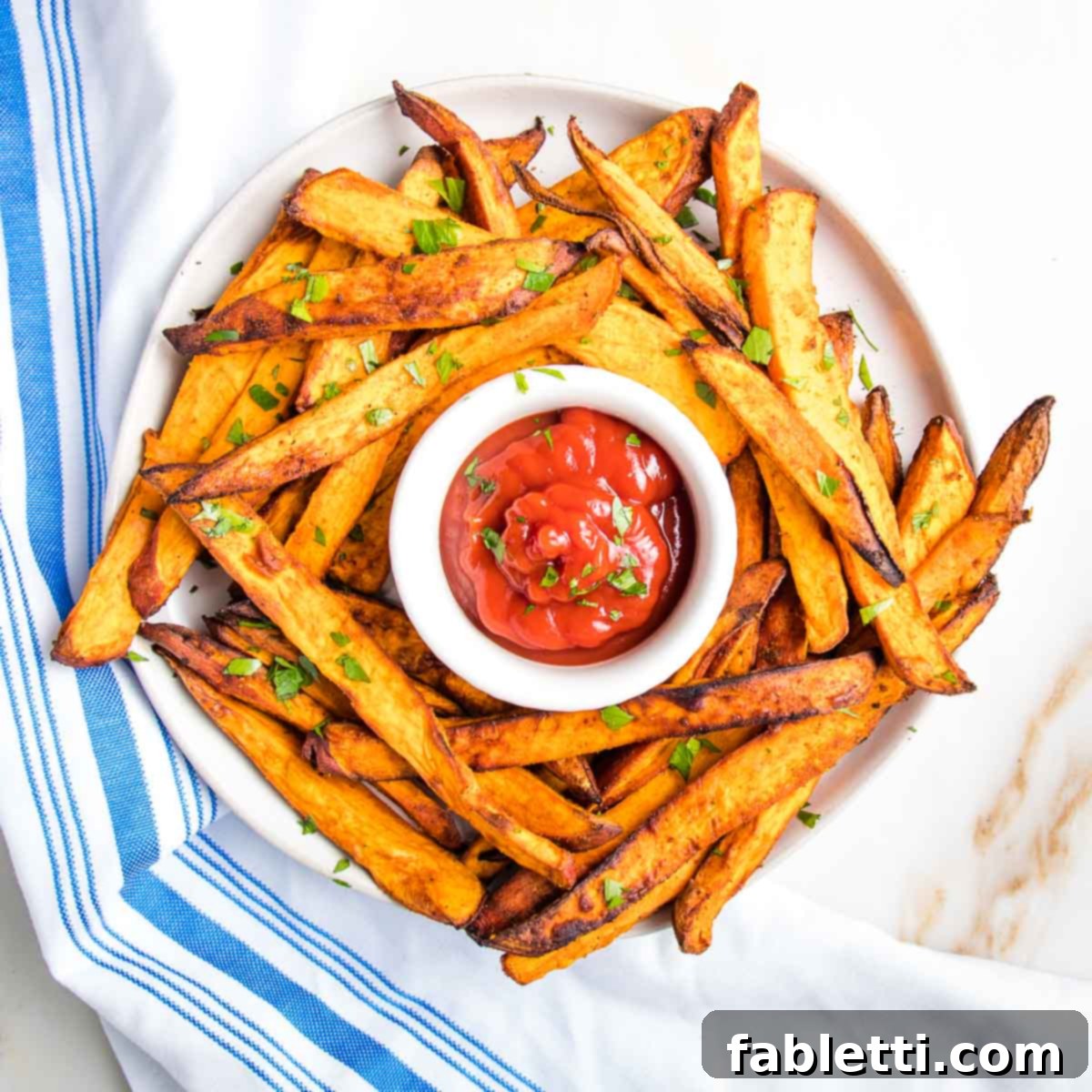Craving a delightful and wholesome snack or side dish? Look no further than perfectly crispy sweet potato fries! Whether you prefer the speedy convenience of an air fryer or the consistent crunch of an oven-baked batch, these vibrant fries are a universally loved treat. They’re not just incredibly delicious; they also offer a healthier alternative to traditional potato fries, packed with essential nutrients and natural sweetness. Imagine golden-brown sticks, tender on the inside and irresistibly crisp on the outside, ready to be dipped into your favorite sauce or piled high with creative toppings. This comprehensive guide will walk you through everything you need to know to make the best homemade sweet potato fries, from selecting the right potatoes to achieving that coveted crispy texture every single time, all while highlighting their impressive health benefits and versatile serving options.
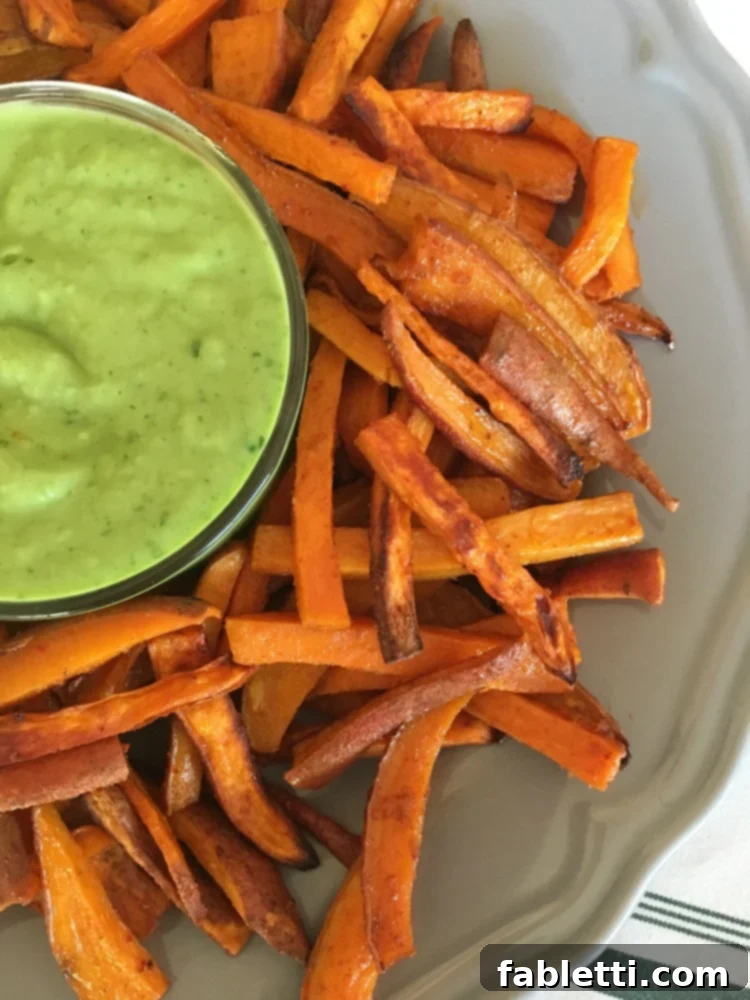
This article has been updated to provide you with the most current and helpful information on crafting the perfect sweet potato fries. We’ve refined our tips and expanded on our insights to ensure your next batch is nothing short of spectacular.
Do you lean towards classic french fries or favor the unique sweetness of sweet potato fries? It’s a tough choice, but when it comes to a healthier option, sweet potato fries often win. They offer a delightful flavor profile and an abundance of nutrients that make them a smart choice for any meal. And let’s be honest, any fry is a good fry when it’s perfectly crispy and accompanied by an amazing dipping sauce! If you’re looking to mix things up, consider making some maple miso potato wedges next time for a savory twist using regular potatoes.
Making crispy sweet potato fries at home is surprisingly simple. With just a few basic ingredients, you can whip up a batch that’s perfect for any time of day, whether as a satisfying snack, a healthy appetizer, or a fantastic side dish. The minimal cleanup and widespread appeal make them a go-to recipe for many. Beyond their ease and popularity, they stand out as a significantly healthier alternative to conventional french fries or even store-bought packaged sweet potato fries. They truly are the ideal healthy accompaniment to virtually any main course you’re serving.
Pro Tip: Elevate your fry experience by taking just five minutes to prepare some easy homemade BBQ sauce for dipping. Your taste buds will thank you later!
Unleash Your Creativity: Loaded Sweet Potato Fries
Once your sweet potato fries are cooked to perfection, transfer them to a large platter and get ready to transform them into a gourmet experience with these delicious toppings:
- Creamy Vegan Sour Cream for a cool, tangy contrast.
- Fresh, chunky Guacamole for a rich and satisfying layer.
- Vibrant Fresh Tomato Salsa to add a burst of flavor and color.
- Savory Roasted Broccoli for an extra boost of greens and texture.
- Hearty Chili – the ultimate comfort food combination for “chili fries”!
- An assortment of finely chopped fresh veggies: creamy avocado, crisp scallions, zesty diced red onion, fragrant fresh cilantro, and colorful bell peppers.
- A drizzle of refreshing Avocado Lime Dressing or a kick of flavor from Creamy Vegan Chipotle Dressing.
Sweet Potato Fries Nutrition: A Healthier Indulgence
While often enjoyed as a treat, sweet potato fries offer a surprising array of nutritional advantages. Unlike their regular potato counterparts, sweet potatoes are remarkably nutrient-dense, making them a more wholesome choice. Notably, pairing sweet potatoes with healthy fats, such as the avocado oil used in this recipe, significantly enhances the body’s ability to absorb their fat-soluble nutrients, maximizing their health benefits.
- VITAMINS: Sweet potatoes are celebrated for their rich content of beta-carotene, which the body efficiently converts into Vitamin A. This crucial vitamin plays a vital role in bolstering our immune system, maintaining healthy vision, promoting radiant skin, and strengthening nails. It also helps combat oxidative stress and contributes to a healthy gut environment. Additionally, sweet potatoes provide a good dose of Vitamin C, essential for tissue repair and overall immune function.
- Anti-inflammatory Properties: These vibrant tubers contain compounds like cyanidin and choline, which are known for their anti-inflammatory effects. They assist the body in eliminating toxins and offer protection against various long-term illnesses, contributing to overall well-being.
- Fiber Powerhouse: Sweet potatoes boast both soluble and insoluble fiber. Soluble fiber helps regulate blood sugar and cholesterol levels, while insoluble fiber aids in promoting digestive regularity and maintaining a healthy gut microbiome, which is crucial for nutrient absorption and overall health.
- Essential Minerals: They are a good source of vital minerals such as magnesium, potassium, and biotin. Magnesium is known to help ease stress and support muscle and nerve function. Potassium is key for maintaining healthy blood pressure and fluid balance, while biotin is important for metabolic processes.
- Potent Antioxidants: The rich orange flesh of sweet potatoes is loaded with antioxidants that protect our cells from daily damage caused by free radicals. This cellular protection is vital for promoting healthy brain function and supporting a thriving gut.
- Low on the Glycemic Index: Compared to many other starchy foods, sweet potatoes have a relatively low glycemic index. This means they release their carbohydrates slowly into the bloodstream, helping to stabilize blood sugar levels and provide sustained energy, avoiding rapid spikes and crashes.
Selecting the Perfect Sweet Potatoes for Fries
The secret to exceptional sweet potato fries starts with choosing the right ingredients. Here’s how to pick the best sweet potatoes for that ideal crispy exterior and tender, sweet interior:
Look for firm sweet potatoes with smooth, unblemished skin. The deeper and more uniform the color, the better, indicating a rich beta-carotene content. Avoid any potatoes with cracks, soft spots, or bruises, as these are signs of poor quality or spoilage. Generally, smaller to medium-sized potatoes tend to be sweeter and have a creamier texture when cooked, making them ideal for fries.
Opt for Red or Orange Varieties: Sweet potatoes with red or orange flesh, such as the widely available Jewel or Garnet varieties, are typically less starchy and more moist and creamy inside. These are your best bet for the classic sweet potato fry experience. The vibrant orange varieties, in particular, are exceptionally high in beta-carotene.
Avoid Starchier Types for Crispy Fries: Some sweet potato varieties are drier and more starchy, resembling russet potatoes in texture. These often include those with lighter tan or purple skins, or Japanese sweet potatoes which have white flesh. While delicious in other applications, these types are generally not recommended if your goal is crispy-on-the-outside, moist-on-the-inside fries, as their higher starch content can make them less prone to crisping up well.
A Note on “Yams”: Be mindful that red and orange sweet potatoes are sometimes mistakenly labeled as “yams” in grocery stores. True yams are botanically different, featuring dry, starchy flesh and thick, rough skins. Real yams are not suitable for making fries due to their extremely dry texture and challenging skins.
How to Identify Spoiled Sweet Potatoes
To ensure you’re always cooking with the freshest ingredients, it’s important to know the signs of a bad sweet potato:
- Visual Cues: Black or brown spots on the skin or flesh are clear indicators of rotting and mean the sweet potato should be discarded. Any visible mold or sprouts that have developed (especially if they look unhealthy or are extensive) also suggest the potatoes are no longer fresh. A shriveled or wrinkled sweet potato signifies significant moisture loss, a definite sign of spoilage.
- Texture: Gently squeeze the potato. Any soft or mushy areas indicate decay and that the vegetable is past its prime.
- Odor: Fresh sweet potatoes have a mild, earthy smell. If you detect a strong, unpleasant, or sour odor, it’s a sign that the sweet potato has gone bad and should not be used.
Optimal Storage for Sweet Potatoes
Proper storage is key to extending the freshness and quality of your sweet potatoes:
- Uncooked Sweet Potatoes: Store fresh, uncooked sweet potatoes in a cool, dark, and well-ventilated place, such as a pantry or root cellar. Ensure they have adequate air circulation to prevent moisture buildup and spoilage. Under these conditions, they can last anywhere between 4 to 6 weeks.
- Avoid the Refrigerator: Do not store raw sweet potatoes in the refrigerator. Cold temperatures can negatively impact their flavor, cause the texture to become mealy, and lead to the development of a hard, woody center when cooked.
- Cooked Sweet Potatoes: Once cooked, sweet potato fries or other dishes can be stored in an airtight container in the refrigerator for up to 5 days. For longer storage, cooked sweet potatoes can be frozen for up to 3 months.
What to Pair with Sweet Potato Fries: Main Dish Inspirations
Sweet potato fries are incredibly versatile and make a fantastic accompaniment to a wide variety of main dishes. Here are some delicious ideas to complete your meal:
- Hearty Vegan Meatloaf for a comforting, plant-based dinner.
- Flavorful Quinoa Veggie Burgers, a nutritious and satisfying burger alternative.
- Light and refreshing Vegan Chicken Salad, perfect for sandwiches or lettuce wraps.
- Crispy and wholesome Healthy Baked Falafel, a Mediterranean delight.
- Savory White Bean Burgers, offering a different texture and flavor profile.
- Deliciously creamy Vegan Tuna Salad for a classic deli-style meal.
- Robust Black Bean Veggie Burgers, a popular and flavorful choice.
- Crisp and tender Zucchini Corn Fritters, a great way to enjoy seasonal vegetables.
Mastering the Cut: How to Prepare Sweet Potatoes for Fries
Achieving perfectly uniform fries is key to even cooking and maximum crispiness. Follow these steps for ideal sweet potato fry preparation:
Start by thoroughly rinsing your sweet potatoes under running water and scrubbing off any loose dirt. A vegetable brush or loofah can make this easier. Importantly, leave the skins on! The skin is where a significant concentration of vitamins, minerals, and antioxidants is found, offering added nutritional benefits and texture.

First, slice off a thin piece of potato from one lengthwise side. This creates a flat, stable surface, allowing the potato to sit securely on your cutting board and preventing it from rolling as you cut.
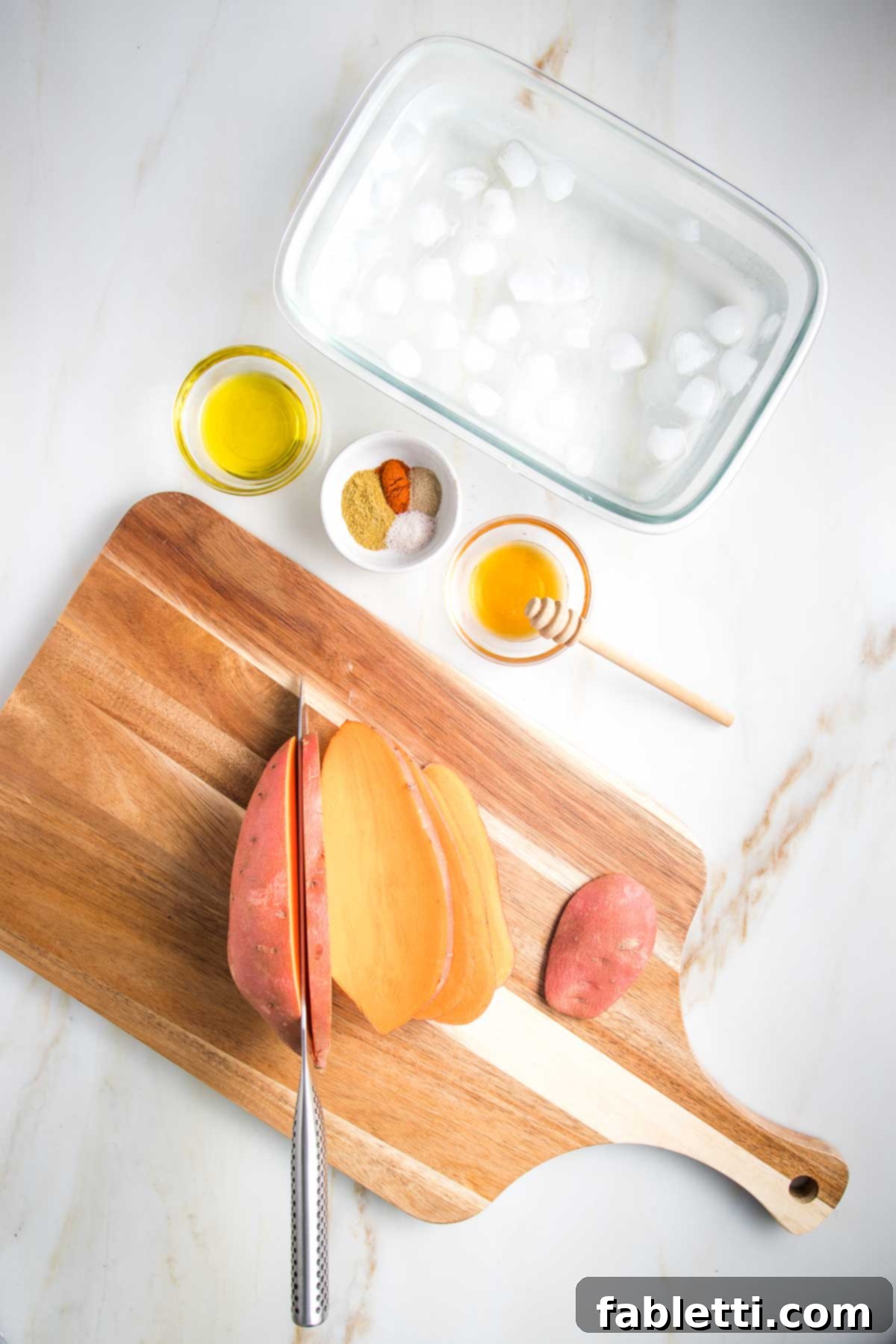
Next, cut the sweet potato into approximately ¼-inch thick ovals or rounds. Consistency in thickness is crucial for even cooking.

Stack these ovals neatly and then cut them again, this time into ¼-inch slices in the opposite direction. This technique will yield uniform, french-fry-shaped sticks.
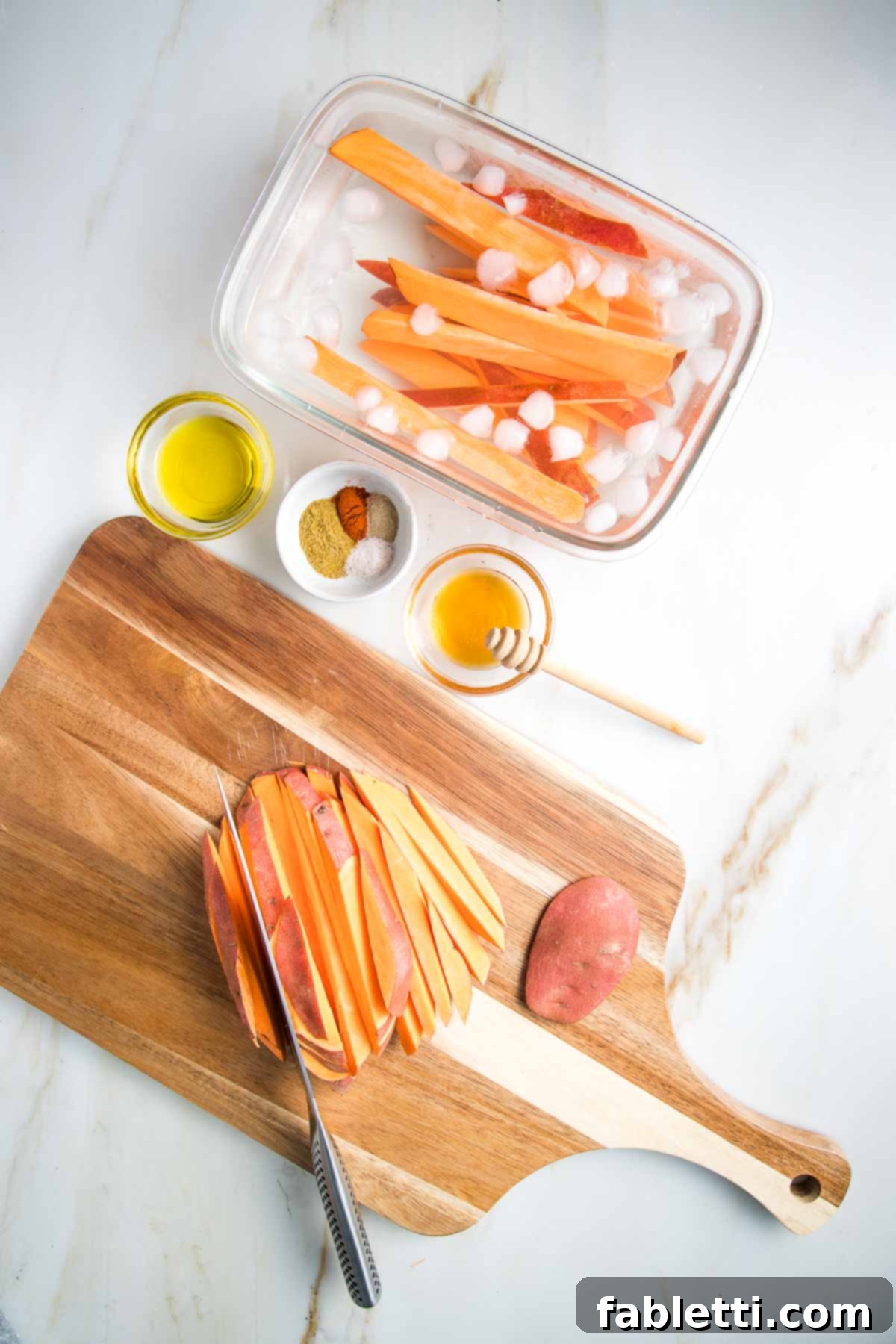
Immediately after cutting, place the sweet potato fries into a large bowl filled with cold water. Adding ice cubes will help keep the water chilled, which is beneficial for the soaking process.
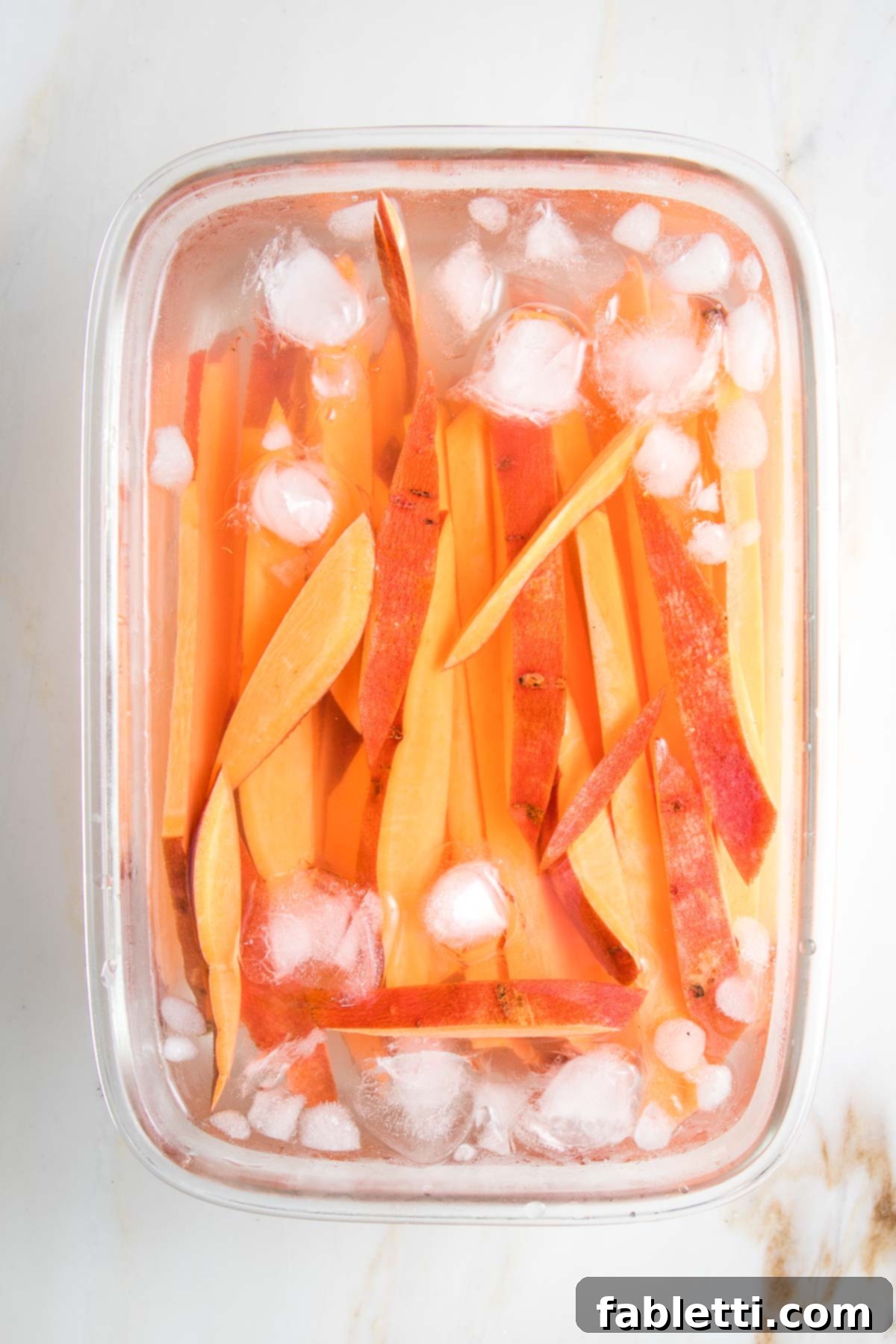
Allow the potato slices to soak for a minimum of 30 minutes. If you plan to soak them for longer than an hour, or even overnight, place the bowl of soaking potatoes in the refrigerator to maintain freshness.

After soaking, thoroughly drain the water and rinse the fries. The most crucial step for crispiness is to pat the potatoes completely dry using paper towels or a clean kitchen towel. If desired, whisk honey into the avocado oil before drizzling it over the dried fries. Finally, sprinkle with cumin, paprika, sea salt, and white pepper, then toss until every fry is evenly coated. This ensures consistent flavor and helps achieve that golden crust.
The Secret to Ultimate Crispiness: Do Sweet Potatoes Need to Be Soaked Before Frying?
While it’s not strictly mandatory to soak sliced sweet potatoes before cooking, this simple step is a game-changer if you’re aiming for truly crispy fries. Soaking sweet potatoes in cold water helps to draw out excess starch from the potatoes. This process prevents the fries from becoming gummy or soggy during cooking and allows them to achieve a much crispier exterior while retaining a tender, fluffy interior. For the best results, especially if you desire that coveted crunch, don’t skip the soak!
Crispy Air Fryer Sweet Potato Fries: Quick & Effortless

The air fryer is a fantastic tool for achieving super crispy sweet potato fries with less oil. Here’s how to get it right:
- Preparation is Key: Begin by cutting your sweet potatoes into uniform long, thin fries or wedges. Consistency ensures even cooking.
- Soak for Success: As mentioned, soaking the cut sweet potatoes in cool water for at least 30 minutes is essential. This step releases excess starch, which is crucial for achieving that desirable crispy exterior while keeping the inside wonderfully soft and creamy.
- Season Generously: After thoroughly drying the soaked fries, toss them with a light coating of avocado oil and your chosen spices. Ensure every piece is evenly coated.
- Preheat Your Air Fryer: Always preheat your air fryer to the specified temperature before adding the fries. A hot start is vital for instant crisping and prevents steaming.
- Avoid Overcrowding: This is perhaps the most critical rule for air frying. Do not overcrowd the basket! Fries that are piled too high will steam rather than air fry, resulting in a soft, soggy texture instead of a crisp one. Cook in batches if necessary, ensuring a single layer or a very loose double layer at most.
- Flip for Evenness: Halfway through the cooking time, use tongs to carefully turn the fries over. This promotes even browning and crispiness on all sides.
Golden Perfection: Tips for Making Crispy Sweet Potato Fries in the Oven
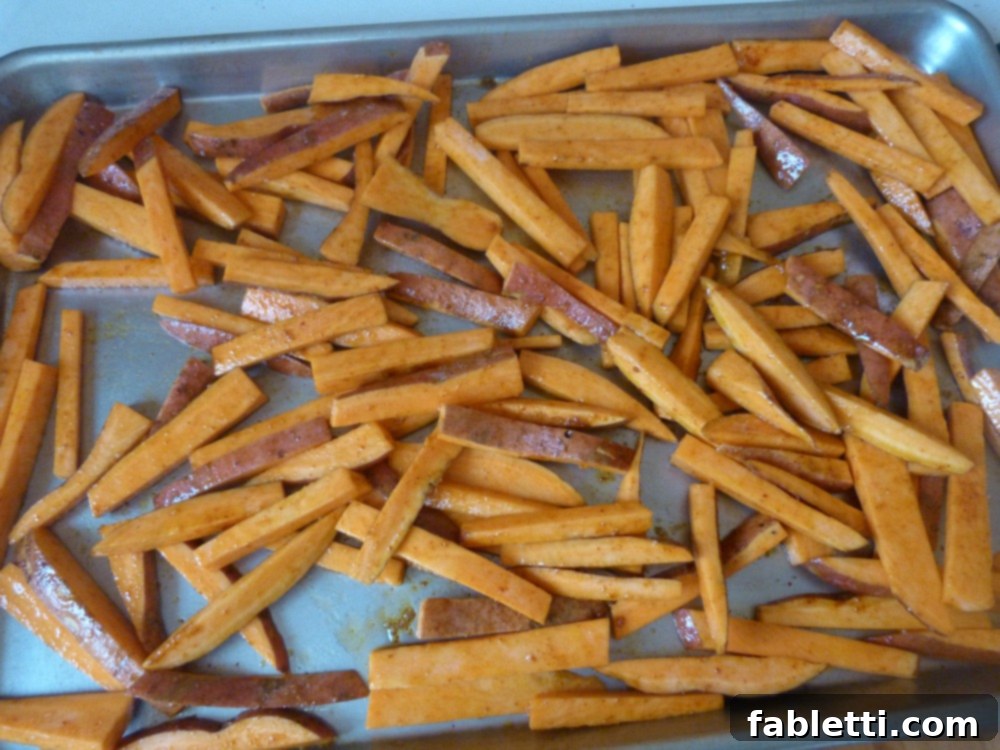
Achieving oven-baked sweet potato fries that are genuinely crispy is entirely possible with the right technique. Here’s how to get that golden, crunchy texture:
- The Essential Soak: Just like with air frying, soaking your cut sweet potatoes in cold water is crucial to draw out excess starch. This is the first step towards a crispier end product.
- Thorough Drying is Non-Negotiable: After soaking, meticulously pat the fries completely dry. Any residual moisture will cause them to steam instead of crisp, resulting in soggy fries. Don’t rush this step!
- Single Layer Spread: For the ultimate crispy sweet potato fries, arrange them on your baking tray in a single layer. This allows hot air to circulate freely around each fry, promoting crispness. If your fries won’t fit in a single layer, use a second pan. Overcrowding is the enemy of crispy fries, leading to soft and soggy results.
- High Heat is Key: Preheat your oven to a high temperature, typically 450°F (230°C). High heat encourages rapid moisture evaporation and crisping. If your oven has a convection bake setting, utilize it at 425°F (220°C); convection ovens circulate hot air more efficiently, often yielding even crispier results.
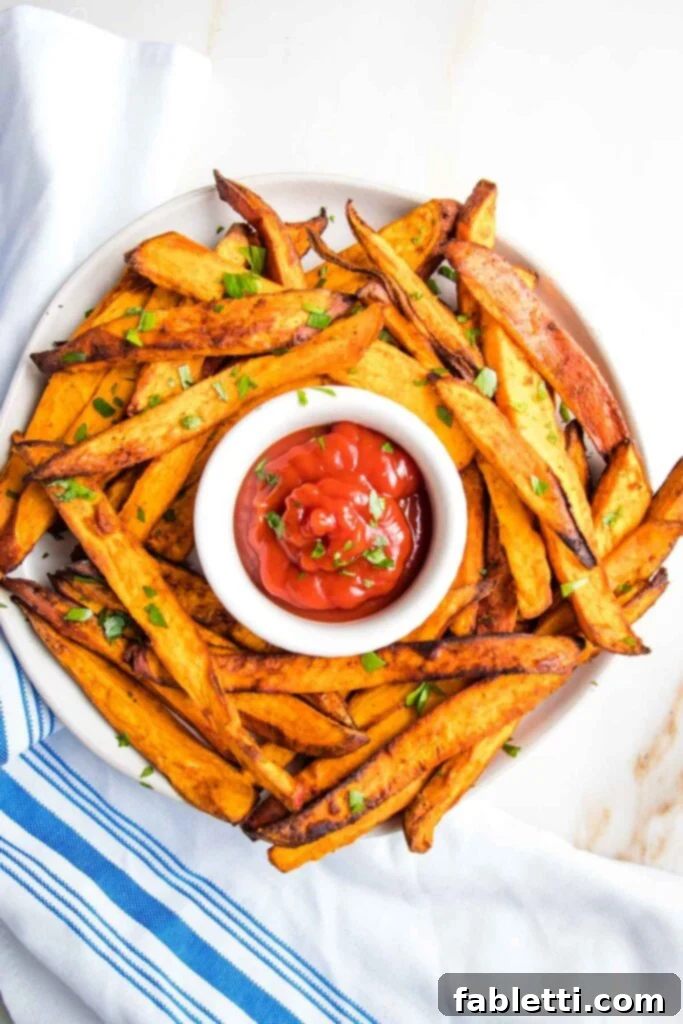
For the absolute best taste and texture, sweet potato fries are best enjoyed immediately after they come out of the air fryer or oven, while they are still hot and perfectly crisp.
Meal Prep and Storage: Enjoying Sweet Potato Fries Anytime
Sweet potato fries are a fantastic dish to incorporate into your meal planning, offering convenience without sacrificing flavor. Here’s how to best prepare, store, and reheat them:
- SERVE: While they are always best fresh and hot, sweet potato fries pair wonderfully with veggie burgers and a crisp side salad for a complete and balanced meal.
- PREP AHEAD: To save time on busy days, you can prepare the sweet potatoes in advance. Cut them into fries and leave them soaking in cold water. This can be done for a minimum of 30 minutes or extended up to overnight. Store the bowl of soaking fries in the refrigerator if soaking for more than an hour.
- STORE: Leftover sweet potato fries (though who ever has leftovers?!) can be stored in an airtight container in the refrigerator for up to 5 days. For best results, reheat them in a preheated air fryer at 375°F (190°C) for about 5 minutes, or in a 450°F (230°C) oven for approximately 10 minutes, until they regain their crispness.
- FREEZE: To freeze cooked sweet potato fries, first lay them in a single layer on a parchment-lined baking tray and place them in the freezer until fully hardened. Once frozen solid, transfer them to a freezer-safe zip-top bag, removing as much air as possible, and store them in the freezer for up to 3 months. When ready to enjoy, reheat frozen fries in a preheated air fryer at 375°F (190°C) for about 10 minutes, tossing halfway through. Alternatively, reheat them on a parchment-lined baking tray in a preheated 450°F (230°C) oven for about 20 minutes, flipping halfway.
The Best Sweet Potato Fries Sauces: Beyond Ketchup
While ketchup is a classic, many commercial brands are loaded with added sugars. For a healthier option, seek out an organic, sugar-free ketchup in a glass container. Or, better yet, think outside the box and create your own delicious, homemade sweet potato fries dip! Homemade sauces not only allow you to control the ingredients but also add a gourmet touch to your fries. Here are some incredible ideas:
- Creamy and tangy Vegan Avocado Dressing.
- Sweet and zesty Mango Dressing for a tropical twist.
- Aromatic and fresh Vegan Basil Pesto for a savory herb kick.
- Spicy and rich Chipotle Salad Dressing for a smoky heat.
- Earthy and bright Green Tahini Sauce, a Middle Eastern-inspired option.
- Cool and herbaceous Vegan Ranch Dressing, a universally loved classic.
- Bold and savory Vegan Caesar Dressing for a surprising depth of flavor.
Expert Tips for Sweet Potato Fries Success

Master the art of making the best sweet potato fries with these insider secrets:
- Homemade is Healthier and Easier: There’s no need to buy pre-packaged frozen sweet potato fries when they are so incredibly easy to make from scratch yourself. By making them at home, you have complete control over the ingredients, ensuring healthy fries free from unwanted additives.
- Keep the Skin On: Don’t peel your sweet potatoes! Not only does leaving the skin on save you precious time during preparation, but the skins are also densely packed with vitamins, minerals, and potent antioxidants, significantly boosting the nutritional value of your fries.
- Innovate Your Dips: Break free from traditional ketchup! Explore creative and flavorful dipping sauces to complement your sweet potato fries. Next time, try a vibrant vegan pesto or a zesty avocado dressing. These options not only add incredible flavor but also contribute additional nutrition to your snack.
- Choose the Right Oil: Avocado oil is an excellent choice for baking or air frying sweet potato fries. It boasts a higher smoke point than olive oil, making it more stable for high-heat cooking and preventing unhealthy breakdown. Furthermore, using healthy fats like avocado oil aids the body in better absorbing the fat-soluble nutrients present in sweet potatoes.
- Achieve Ultimate Crispiness: To prevent soggy sweet potato fries, the most crucial step after soaking is to thoroughly pat them dry. Any residual moisture on the surface will create steam, hindering the fries from developing that perfect crispy texture.
- Season for Flavor, Control for Sodium: For fries with a saltier taste without excessively increasing sodium content, hold off on adding salt during the seasoning process. Instead, sprinkle the sea salt generously over the fries immediately after they come out of the oven or air fryer, while they are still hot. This allows the salt to adhere better and provides a more pronounced salty flavor with less overall sodium.
Explore More Healthy Sweet Potato Recipes
- Vegan Lentil Salad
- Vegan Shepherd’s Pie with Sweet Potato Mash
- Sweet Potato Black Bean Burgers
- Fall Harvest Salad with Apple Vinaigrette
Did you find this recipe helpful? Your feedback is invaluable! If you made these delicious sweet potato fries, please consider leaving a five-star rating and a comment below to support your favorite food bloggers. We’d also love to see your culinary creations! Share your photos on Instagram by tagging me @dkhealthcoach and using the hashtag #debraklein.
📖 Recipe: Crispy Sweet Potato Fries

Sweet Potato Fries
Debra Klein
Pin Recipe
Equipment
- Baking sheet
- Tongs
- Mixing Bowls with Lids
- Air Fryer
Ingredients
- 3 medium-large sweet potatoes
- 1 teaspoon cumin
- ½ teaspoon paprika
- ½ teaspoon sea salt
- ¼ teaspoon white pepper
- 2 Tablespoons avocado oil
- 1 Tablespoon honey optional
Instructions
- Prep your sweet potatoes. Scrub and pat dry the potatoes. No need to peel; sweet potato skins are packed with health benefits. Cut off a very thin slice vertically from one side so the potato sits flat on your cutting board. Then, cut into ¼-inch thick discs, and turn the opposite way to cut into ¼-inch fries.
- Place sliced potatoes into a bowl of cold water for at least 30 minutes.
- Dry potatoes completely with paper towels before continuing. This step is crucial for crispiness.
- OVEN METHOD: Preheat oven to 450°F (230°C). Line a large rimmed baking tray with unbleached parchment paper for easy clean-up.
AIR FRYER METHOD: Preheat air fryer to 375°F (190°C). - Mix cumin, paprika, salt, and pepper in a small bowl and set aside.
- If using honey, whisk it into the avocado oil in a small bowl until well mixed.
- Drizzle the thoroughly dried potatoes with the oil (and honey mixture, if using), then sprinkle evenly with the spice mixture. Mix until all fries are well coated.
- For Oven: Spread fries onto a baking sheet in a single layer, ensuring they have enough room. Use more than one tray if necessary. For Air Fryer: Load the air fryer basket with a single layer of fries. You may need to cook in batches.
- OVEN: Roast in the preheated 450°F (230°C) oven for 20 minutes. Toss the fries, then roast for an additional 15 minutes, or until golden and crispy.
AIR FRYER: Cook for 7 minutes. Use tongs to toss, then cook for an additional 7 minutes, or until crispy and cooked through.
Notes
Nutrition
Calories: 104kcal
Carbohydrates: 15g
Protein: 1g
Fat: 5g
Saturated Fat: 1g
Polyunsaturated Fat: 4g
Sodium: 198mg
Fiber: 2g
Sugar: 7g
Note
The nutrition calculations were done using online tools. To obtain the most accurate representation of the nutritional information in any given recipe, you should calculate the nutritional information with the actual ingredients you used. You are ultimately responsible for ensuring that any nutritional information is accurate, complete and useful.
